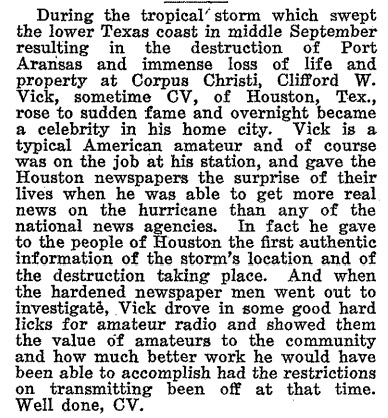This week marks the 100th anniversary of the 1919 Florida Keys Hurricane, which also had a major impact in Louisiana and Texas, in addition to the Caribbean. On September 7, 1919, the storm strengthened to hurricane intensity over the Bahamas, and continued to grow as it zeroed in on Key West. It ultimately strengthened to category 4 before making landfall at Dry Tortugas. The storm was the second strongest since 1851, and the ninth deadliest in U.S. history, with 772 fatalities.
Outside of the Keys, the state of Florida was relatively unscathed, although communications south of Miami was cut off. After the storm crossed into the Gulf, there was a false rumor that it had turned toward Louisiana. This caused warnings to be taken down for Corpus Christi, Texas, the day before landfall. Although the warning was re-instituted, the city was unprepared for the storm surge as high as 16 feet.
Among the dead were 310 in Texas, as well as 488 persons aboard a steamer found sunk between Key West and the Dry Tortugas. One of the survivors of the storm was a six year old Robert Simpson, who did have one family member perish in the storm. He went on to become a meteorologist and along with Herbert Saffir devised the Saffir-Simpson Hurricane Scale.
 Amateur Radio was still off the air, since restrictions on transmitting were not removed until October 1, 1919. Receiving, however, had been allowed since April 15, and Houston amateur radio operator Clifford W. Vick became a bit of a celebrity in his hometown by copying radio traffic related to the storm and passing these dispatches on to the local newspapers. The clipping at left appeared in QST in December 19, and notes that Vick made the point to the Houston papers that he could have done more good if the transmitting restrictions had been lifted.
Amateur Radio was still off the air, since restrictions on transmitting were not removed until October 1, 1919. Receiving, however, had been allowed since April 15, and Houston amateur radio operator Clifford W. Vick became a bit of a celebrity in his hometown by copying radio traffic related to the storm and passing these dispatches on to the local newspapers. The clipping at left appeared in QST in December 19, and notes that Vick made the point to the Houston papers that he could have done more good if the transmitting restrictions had been lifted.

Corpus Christi after the storm. Wikipedia photo.

